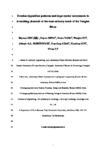Erosion-deposition patterns and depo-center movements in branching channels at the near-estuary reach of the Yangtze River
| dc.contributor.author | Zhu, B | |
| dc.contributor.author | Deng, J | |
| dc.contributor.author | Tang, J | |
| dc.contributor.author | Yu, W | |
| dc.contributor.author | Borthwick, Alistair | |
| dc.contributor.author | Chai, Y | |
| dc.contributor.author | Sun, Z | |
| dc.contributor.author | Li, Y | |
| dc.date.accessioned | 2021-08-22T11:10:23Z | |
| dc.date.available | 2021-08-22T11:10:23Z | |
| dc.date.issued | 2020-09 | |
| dc.identifier.issn | 2095-0195 | |
| dc.identifier.issn | 2095-0209 | |
| dc.identifier.uri | http://hdl.handle.net/10026.1/17654 | |
| dc.description.abstract |
Channel evolution and depo-center migrations in braided reaches are significantly influenced by variations in runoff. This study examines the effect of runoff variations on the erosion-deposition patterns and depocenter movements within branching channels of the near-estuary reach of the Yangtze River. We assume that variations in annual mean duration days of runoff discharges, ebb partition ratios in branching channels, and the erosional/depositional rates of entire channels and sub-reaches are representative of variations in runoff intensity, flow dynamics in branching channels, and morphological features in the channels. Our results show that the north region of Fujiangsha Waterway, the Liuhaisha branch of Rugaosha Waterway, the west branch of Tongzhousha Waterway, and the west branch of Langshansha Waterway experience deposition or reduced erosion under low runoff intensity, and erosion or reduced deposition under high runoff intensity, with the depocenters moving upstream and downstream, respectively. Other waterway branches undergo opposite trends in erosion-deposition patterns and depo-center movements as the runoff changes. These morphological changes may be associated with trends in ebb partition ratio as the runoff discharge rises and falls. By flattening the intra-annual distribution of runoff discharge, dam construction in the Yangtze Basin has altered the ebb partition ratios in waterway branches, affecting their erosion-deposition patterns and depo-center movements. Present trends are likely to continue into the future due to the succession of large cascade dams under construction along the upper Yangtze and ongoing climate change. | |
| dc.format.extent | 537-552 | |
| dc.language | en | |
| dc.language.iso | en | |
| dc.publisher | Springer Science and Business Media LLC | |
| dc.title | Erosion-deposition patterns and depo-center movements in branching channels at the near-estuary reach of the Yangtze River | |
| dc.type | journal-article | |
| dc.type | Journal Article | |
| plymouth.issue | 3 | |
| plymouth.volume | 14 | |
| plymouth.publication-status | Published | |
| plymouth.journal | Frontiers of Earth Science | |
| dc.identifier.doi | 10.1007/s11707-019-0808-2 | |
| plymouth.organisational-group | /Plymouth | |
| plymouth.organisational-group | /Plymouth/Faculty of Science and Engineering | |
| plymouth.organisational-group | /Plymouth/Faculty of Science and Engineering/School of Engineering, Computing and Mathematics | |
| plymouth.organisational-group | /Plymouth/Users by role | |
| plymouth.organisational-group | /Plymouth/Users by role/Academics | |
| dc.identifier.eissn | 2095-0209 | |
| dc.rights.embargoperiod | Not known | |
| rioxxterms.versionofrecord | 10.1007/s11707-019-0808-2 | |
| rioxxterms.licenseref.uri | http://www.rioxx.net/licenses/all-rights-reserved | |
| rioxxterms.type | Journal Article/Review |


